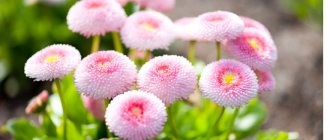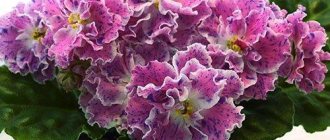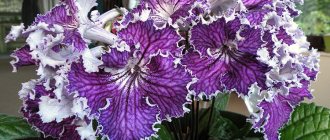- February 2, 2019
- Houseplants
- Natalia Bardo
Azalea is a stunning flower that delights the eyes of those who look at it. This plant surprises with its extraordinary beauty, as well as its ability to bloom abundantly and brightly. Let us next consider the main features of growing this plant, as well as some of its varieties.
General information
The first exterior feature that is noticeable in the photo of an indoor azalea is its elegance combined with decorativeness. It is distinguished by lanceolate leaves, the shape of which resembles an egg, as well as a lignified trunk, the height of which can reach from 30 cm to 1 meter. Flowers come in different shades and sizes, this directly depends on the plant variety. The structure of the bush also determines the appearance of a particular specimen. Some azalea inflorescences are presented quite simply, while others are distinguished by their lushness and intricately twisted leaves. Reviews say that at the time of flowering there is a pleasant aroma in the room.
If you look at the photo of an indoor azalea, you get the impression that this flower has absorbed the best features that plants can have. Its main advantage is the abundance of flowers. To complement your plant design with such a specimen, novice gardeners will have to make some sacrifices, since it has certain care requirements. This is why you need to know about them before purchasing flowers. As practice shows, if you choose the right plant variety and care for it in strict accordance with all the rules, then a small ornamental shrub will delight its owners with luxurious flowering, which, if successful, will last from November to May.
Types and varieties with photos
All bred indoor varieties are divided into early-flowering, mid-flowering and late-flowering. The most common plant for indoor floriculture is Azalea Mix. Breeders bred it from Indian and Japanese species, instilling the best maternal qualities. The species combines several varieties, of which the most popular are Simsi azalea and Dwarf pink azalea.
These are azalea bushes 50-60 centimeters high, which are easy to form a crown and have a long flowering period. Flowers are formed in the axils of the shoots, size - 4-5 centimeters. Mixes bloom from December to March and are distinguished by a variety of colors. As you can see in the photo of azaleas, they can be pink, soft lemon, or dark scarlet.
Whatever variety of exotic beauty you choose and whatever types of flowering azalea exhibits, you should know that absolutely all representatives of this flowering crop form buds only in cool rooms.
This is precisely the condition that must be met in houses and apartments.
Early flowering
The first buds appear at the end of October, flowering continues until mid-January. This azalea is easier to grow than species that bloom later. In October and November, it is quite possible to keep it on a glassed-in loggia, where the temperature is lower than in the apartment.
Early flowering azalea varieties:
- Doberlug is a product of breeding work by German flower growers. It is distinguished by large double pink flowers decorated along the edge with a white stripe.
- Eri - petals of a carmine pink hue, the border spreads along the edge and does not have a clearly defined shape.
- Adventglockchen - bell-shaped “roses”, scarlet, raspberry-red shade, bud size 5-6 cm.
Species with unusual colors deserve special attention. In the photo, the Dresden azalea looks impressive, abundantly strewn with salmon-colored buds.
Medium flowering
In conditions of short daylight hours, the azalea plant is able to become covered with lush flowers even in severe winter. Flower growers distinguish varieties:
- Albert-Elizabeth is a champion in bud size. The flowers are pink with a pronounced terry border along the edge of the petals.
- Apollo - attracts attention with an unusual pattern of red and brown spots on snow-white petals.
- Knut Erwen - red and bright scarlet buds contrast effectively against the background of dark green leaves.
The flowering period lasts from January to March.
Useful reading: Peony roses: history of origin, description of species and varieties, breeding rules.
Late bloomers
The most noteworthy varieties:
- Sakuntala - a distinctive feature is a greenish pattern of specks on white petals.
- Niobe, another white representative of the genus, looks unusual due to the alternation of greenish and red spots.
- Professor Wolters - the buds are funnel-shaped, salmon color, shaded by a crimson border along the terry edge.
The time when late varieties of azalea blooms is February to May.
Common varieties
Today, a large number of azalea varieties are known in the world. However, as practice shows, not all of them grow at home.
In modern apartments you can grow azaleas, which come from India (Rhododendron Simsii), as well as from Japan (Rhododendron Obtusum). Let us next consider in more detail the characteristics of each plant from the presented varieties.
Japanese azalea is a plant that often decorates not only window sills in apartments, but also areas of greenhouses, as well as gardens. When growing this specimen in apartment conditions, it, as a rule, does not even reach 60 cm in height. When mature, the Japanese azalea becomes very large, taking on the appearance of a pillow strewn with flowers. A plant of this variety responds well to temperature changes, as well as to pruning and shaping. In modern indoor floriculture, varieties of Japanese azalea such as Melina, as well as Kermesina Alba (pictured below), are very popular.
Speaking about the Indian azalea, it should be noted that plants whose varieties come from such an exotic country are used as the basis for breeding the most beautiful species of the variety in question. When grown indoors, Indian azaleas are small. The height of adult plants, as a rule, fluctuates around 40-60 cm, but in the garden it will turn into a real tree, the height of which can be about 170 cm. The main difference between the Indian azalea and the Japanese one is that it is characterized by larger flowers. The most popular indoor varieties of this species are Stella Maris, Albert-Elizabeth, Knap Hill, Golden Eagle, as well as Knap Hill Sylphides and deciduous Jolie Madame (pictured below).
Let us next consider the features of growing azaleas indoors.
Hybrid varieties of garden azalea
Based on the listed varieties, many hybrid varieties of frost-resistant azaleas have been created, which are maximally adapted for growing in Russia and the CIS countries.
Golden Lights
A deciduous representative of winter-hardy varieties of azalea “Golden Lights” (A. Golden Lights) was bred by American breeders in 1975. The height of the five-year-old shrub is 1.3 m, older specimens grow up to two meters. The width is about 1-2 m. The crown is hemispherical, very dense.
Azalea Golden Lights (azalea golden lights)
Cilia run along the edge of the elliptical leaf blade. In mid-May, many single flowers of a very juicy light tangerine color appear. The maximum permissible limit is -34 °C.
Deciduous azalea "Golden Lights" should be planted from mid-spring to late summer.
Geisha
Azalea "Geisha" (A. Geisha) is characterized by relatively fast growth and high frost resistance. A dense, cushion-shaped, well-branched bush of 50 cm in height can withstand temperatures down to -27°C. Dark emerald glossy leaves turn burgundy in cold weather. This azalea is not large-flowered: funnel-shaped lilac or orange flowers do not exceed 2.5 cm in diameter. The flowering plant resembles a lush ball - branches and leaves are completely invisible behind the flowers.
Azalea Geisha
Arima
The abundantly flowering perennial shrub "Azalea Arima" (A. Arima) blooms luxuriantly (but only for a couple of weeks), with large white flowers with a pinkish edge and a yellow spot on the upper petal. The flowers look like lilies and exude an intoxicating aroma. Deciduous rhododendron with vertical shoots grows up to 80 cm and with age acquires a funnel-shaped crown. Bright green wide glossy leaves 10 cm long and about 5 cm wide. The plant can withstand 25-degree frost and needs shelter.
Azalea Arima
In order to preserve flower buds and compactness of the bush, last year's shoots are shortened by a third, a few days after the garden azalea blooms (see photo).
Melina
The lowest among garden azaleas, “Melina” (A. Melina), reaches only 30 cm in height and 70 cm in width. Green oval-oblong leaves turn yellow in autumn. Young shoots are strewn with small light gray fibers. The dwarf shrub blooms with delicate raspberry-pink flowers.
Azalea Melina
Rosie Lights
Perennial Azalea (A. Rosy Lights) is the most frost-resistant garden variety, bred in 1984. Overwinters in open ground at temperatures from -40 degrees. Low, only 90 cm, the bush is absolutely not capricious. Blooms with fragrant pink flowers in the shape of a star.
Perennial pink azalea (azalea rosy lights)
Important! If you want to grow an azalea on your site, think carefully about whether you can and will want to pay enough attention to the plant. A shrub that is remembered only from time to time is unlikely to please with its lush color.
Lighting
When growing azaleas in your own apartment, you need to pay special attention to the lighting of the room. Plants from the rhododendron family, which includes azalea, do not tolerate direct sunlight. To grow them, you should choose places in the room where only diffused light reaches.
If weather conditions allow this, in the summer the plant should be regularly taken out into the fresh air (in the garden or on an open balcony). But for the entire period of being outside, the azalea should be left only in a shaded place. When it rains, it is best to place the shrub outside - it responds well to such conditions.
How can it be dangerous?
Azalea does not emit dangerous allergens and does not emit an unpleasant odor. The plant can be harmful only for people with individual intolerance. However, there are a sufficient number of medical products that can neutralize the effects of allergens.
Despite such positive qualities of the entire species as a whole, the Indian azalea can become a problem . The extract of its leaves, if ingested, will cause pain and cramps in the intestines.
About air humidity
In many photos, the indoor azalea flower appears as a luxurious green shrub, completely covered with bright, blooming buds. Practice shows that an adult plant will only be like this if it is grown in suitable humidity conditions.
Azalea is a plant that loves moist air, which is why it needs to be watered quite often and abundantly. If this is not done, the leaves of the bush gradually turn yellow and begin to fall off, which indicates its slow death. It should be noted that excessive watering can also have a detrimental effect on azaleas - its strong root system begins to rot, which also causes the death of the plant.
When growing a flower at home, you must constantly spray the leaves, as well as the entire space in which it is located. Experienced flower growers share that it is most convenient to carry out this procedure using a spray bottle equipped with a fine spray.
If a plant is grown in a pot, the container with it must be regularly kept in a tray filled with purified water at room temperature. It is necessary to lay sphagnum moss on top of the soil layer - it is this that will help retain more moisture in the ground.
In order to create suitable air humidity conditions for azaleas, many amateur gardeners place a pot with a plant next to a small fountain that sprays water into the air.
Transplanting indoor azaleas at home
Indoor azaleas are replanted only after flowering, when the flower is in a dormant period. Young plants need to be replanted once a year. Upon reaching the age of 3 - 4 years, the azalea is replanted every 3 years or less.
A sign that it is time to replant the azalea flower is the roots coming out of the drainage holes of the pot or visible above the soil surface. You need to replant indoor azaleas very carefully: as already mentioned, the roots of the plant are weak and easily damaged, and the root system itself is superficial and lies shallow. When transplanting azaleas, the earthen ball is not destroyed and the roots are not unraveled.
The new container for azaleas should be slightly larger than the old one (2 - 3 cm), and a drainage layer must be laid at the bottom. The azalea is placed in a new pot so that the root collar is at the same level as before. The soil is poured very carefully, without compacting, but only lightly pressing with your fingers.
After transplanting, the azalea is watered and, if necessary, topped up with soil if it settles.
Watering
Rosalia flowers will be more beautiful, stronger and larger if the gardener provides the plant with proper watering. So, it should be noted that this specimen loves cool, but not icy water. It is better to defend it first. The ideal option for watering the plant is rainwater.
Azalea grown indoors only needs acidified water. In order to ensure such a condition, which is vital for the growth and normal development of the plant, for each liter of water prepared for irrigation, it is necessary to add a little citric acid (if possible, replace it with succinic acid).
On summer days, azalea needs abundant watering. At those moments when flower stalks begin to form on the bush, the volume of liquid supplied must be reduced. It is recommended to do the same in the autumn - practice shows that at the specified time, watering should be done only as the earthen clod dries out. In order to control the degree of soil moisture sufficiently, you can purchase a special device - a hygrometer.
Azalea Planting Basics
Planting rhododendron bushes consists of several stages. The first and perhaps most important is the correct placement of the crop. The landing site should be:
- Well lit, but not with direct ultraviolet light, but with soft, diffused light. The ideal option is to plant the bush in the shade of mature trees.
- Sheltered from winds and drafts. It’s good if there is a cinder block fence or a house wall next to the plant.
- Not flooded by melt or rain water. If we are talking about a large variety with a developed root system, it is important to take into account the depth of groundwater. If the figure does not reach 150 cm, it is better to look for another place or opt for a low-growing bush azalea.
Temperature
Maintaining a suitable temperature regime is another important nuance that you should pay attention to in the process of growing indoor azaleas. In the photos posted in the article, the plants look fresh thanks to the implementation of this rule. They react in a special way to the temperature in the room: if the room is hotter than required, the bush begins to shed its leaves.
The usual temperature for azaleas is cool, as in those places where they grow in their natural environment. That is why, when flower stalks begin to appear, which usually happens at the end of autumn, it is recommended to maintain a temperature in the room no higher than +7 degrees. At the moment when the flowers of the rosalia (photos of which you have already had the opportunity to look at) bloom, it is advisable to increase it by three notches (up to +10). Do not forget that the appearance of your plant will depend on this indicator.
It should be noted that at a time when the plant does not bloom and does not produce flower stalks, it should be in a temperature regime of about +10...+15 degrees.
Surely, knowing about these conditions, many people begin to ask questions about how a person can live with such indicators. Yes, it's really not easy. As practice shows, many gardeners prefer to create a temperature for the plant artificially by lining its pots with dry ice, as well as regularly spraying the bush with cold water, which also maintains the desired level of air humidity.
Difficulties in caring for the plant
Most often problems in caring for Azalea
arise mainly due to the fact that the conditions of its detention are violated.
If you notice wrinkled, drooping buds or leaves on your plant, this indicates that the room temperature is too high, the plant is not watered enough, and the air is very dry.
If Azalea
The foliage falls off and turns yellow, and its flowering is poor; this in most cases indicates that the plant has unsuitable soil and too hard water for irrigation. If mistakes in caring for the plant are systematically repeated, it will be susceptible to various diseases: fusarium, powdery mildew and rust.
Pests attack the flower very rarely. But they also cause trouble.
About soil
Regardless of the variety and type, indoor azaleas prefer the same soil composition - peat. You can buy it in flower and gardening stores, where you can sometimes find prepared mixtures designed specifically for growing these specimens (with a special level of acidity), as well as with a mineral composition. As practice shows, soil mixtures consisting of heather masses mixed with pine needles will be excellent options for growing flowers. As well as compositions intended for the cultivation of acidophilic plants.
In their reviews of growing indoor plants, many gardeners note that peat soil tends to dry out quickly, which subsequently negatively affects the health and flowering of the shrub. An indoor azalea will no longer look like in our photos if you don’t pay attention to it. It should be noted that this phenomenon is a characteristic phenomenon for peat soils, which is due to an insufficient level of moisture. How to deal with such a problem? In order to make the soil more loose and moist, simply dip the pot with the plant into a container of water and leave it there for a while.
One of the main features of growing azaleas indoors is that this plant does not tolerate loosening the soil, which is associated with excessive sensitivity of the roots.
When choosing soil for your pet, you need to pay attention to its acidity level. For azaleas, the optimal pH is 4-4.5.
How to care at different times
Since it is already clear that Azalea reacts sensitively to even minor temperature fluctuations, the change of seasons can greatly affect the growth of the flower. It is important to try to maintain a balance and surround the plant with approximately the same conditions throughout the year. Sometimes you will even have to move the pot from its usual place.
Spring
The beginning of spring is the time of flowering of Azaleas. These days, it is recommended to pay special attention to watering and light spraying with cool, settled water. And be sure to remove any drops from the petals, because otherwise they will become covered with ugly spots.
Azalea must be sprayed with settled water
In spring, and then in summer, Azalea should be fed more often than at any other time of the year. The intensity can be individual, but the most common option for fertilizing is once a week. Preference should be given to those mineral supplements that are rich in potassium and phosphorus.
Azalea blossom
Summer
Summer is, first of all, the time for propagation of Azaleas by cuttings. It is important to choose shoots with buds that have not yet become woody. It is best to give preference to one-year-old shoots.
To ensure that the cuttings take root, it is better to cover them with a bag or glass jar and do not forget to water them well.
The secret of proper care in summer also lies in the need to remove the flower from particularly hot places. It is often advised to move the pot to a room where there is air conditioning or at least the windows face north.
Autumn
If conditions for Azaleas are ideal or close to such, then flowering can continue even until autumn. But usually already in July-August the last flowers fade, and the plant begins to slowly prepare for winter.
At this time, it is recommended to gradually reduce watering , eventually reaching the minimum annual values. You just need to make sure that the soil always remains moist, but not soggy.
Towards the end of autumn and the beginning of winter, you need to keep the flower in a temperature background of +10-12 C. It is believed that such conditions are literally the best for laying the strongest buds, and then the longest flowering.
Winter
The main problem with growing Azaleas in winter is the lack of light. To solve this, artificial lighting is used. And it is especially important to do this when the first buds - future flowers - appear on the plant.
The second feature is the need to strictly observe humidity and temperature, which change due to heating radiators that dry the air or greatly heat the room. Therefore, it is often recommended to even protect the flower pot with screens from the side of the room or choose a place where no more than +18-20 C is stably maintained.
Trimming and pinching
Pruning a plant is a technique that is an integral part of the growing process. It should be noted that this manipulation must be performed only when the indoor azalea (the photo below shows what the plant looks like at rest) has bloomed. When pruning a bush, it is necessary to remove all weak shoots, as well as unwanted elements.
Pinching the bush should be done before the process of bud formation - this period may vary depending on the variety of indoor azalea, but most often it begins in May. During this technique, at least five buds must be left on each young shoot.
Reviews left by those who specialize in growing azaleas say that the abundance of flowering of the plant, as well as the size of the roses, directly depends on the pinching procedure, as well as on the correctness of the owner’s actions.
Diseases and pests
Leaf of an azalea affected by pests
Azaleas often experience leaf loss. The reasons may be either improper watering (both insufficient and excessive), or exposure of the leaves to the sun (then burns occur, and then the greenery dries out).
Among insects, Azalea is favored by spider mites and moths. You can combat them by treating them with soapy water or Bordeaux mixture.
Useful video:
How to form a crown
In many photos of azaleas (flowers in pots) you can see that this plant is presented in the form of a beautifully formed bush, the crown of which is completely covered with bright roses, pleasing to the eye of the beholder. However, in reality, you can notice that this process requires certain skills.
In order to form the correct crown for the future tree, you need to select one of the largest and most powerful branches, which will subsequently serve as the trunk of the composition. It must be left alone, and all other existing shoots must be cut off.
After one branch has been selected, you need to tie it to a fixed support and gradually begin to level it, turning the pot to the sun with the desired side. In order to obtain the spherical shape of an adult plant, you need to regularly pinch out all the shoots that form on the crown. Lateral branches should also be removed regularly.
If you want to form an azalea (indoor flower in the photo) not into a tree, but into a bush, you need to regularly pinch the side shoots, the height of which reaches 12 cm or more. When pruning, make sure that all stems are the same length.
Why do you dream?
Dreams are a window into another intangible dimension, often inspired by images that reach the human mind, foreshadowing various situations in his life. Why do you dream about an azalea flower? There are several options for how a person can dream of a plant and what it will mean:
- If you dream about an azalea flower being dried out or sick , health problems will soon begin that will affect the person or someone close to him or her.
- Rhododendron is on the windowsill - this portends a long trip or business trip.
- A pregnant woman dreamed of a plant - a healthy child or twins will be born.
Reproduction
How does indoor azalea propagate? This plant is easily propagated by seeds, division, grafting, but the best way is cuttings.
In order to propagate a plant at home using the latter method, you can use only healthy woody shoots, the length of which is no more than 5-8 cm. Sometimes some novice gardeners prefer to use green twigs for this - this decision is wrong, since they do not take root , but only wither.
The ideal period for azalea propagation is the beginning of spring (March and April) - a time when the plant has no flowers and is in a green state.
Prepared cuttings should be planted in acidified soil, having previously treated them with preparations that stimulate the process of active formation of the root system. It is necessary to plant prepared cuttings only vertically, without placing them at an angle. After the branches are planted in the substrate, they must be watered and covered with film, which will create a greenhouse effect.
The rooting process of the plant in question occurs only in warmth - the optimal temperature for this is +25 degrees. As practice shows, if all the specified conditions are met, within a month and a half you can get a living plant, which a year later will begin to delight its owner. After the first flowers have withered, the bush can be pruned and pinched, forming its lush and beautiful crown.
Where is the best place to put it?
From the point of view of subtle energies, it is better to place the plant in a room where a person visits often, but for a short time. After all, an oversaturation of the subtle body with positive energy will also upset the balance of the natural flow of its own energies. A good location for the flower would be :
- hallway;
- corridor;
- bathroom;
- toilet.
It is not recommended to place the plant in the bedroom or children's room.
So, azalea is a plant with powerful energy that can restore a person’s strength, support his psychological stability and prevent various conflict situations indoors. Despite its energetic properties, the plant has a magical effect on the world, driving away evil spirits.
When and how often does azalea bloom?
Flowering time depends on the type of flower. Early-flowering varieties, which bloom in late November–early December, and late-flowering varieties produce flower stalks from February to April. Each plant has its own period and flowering time. Azaleas growing indoors bloom during the colder months.
Winter splendor
Garden azalea will delight you with its summer flowering only 3-4 years after planting. During this period, it is necessary to carefully care for the plant, timely watering, fertilizing and pruning. The flowering period depends on the right location. Under favorable conditions, the plant blooms from 20 days to 2.5 months. What needs to be done for the azalea to bloom:
- For lush flowering, the plant requires timely pruning. It is carried out at the end of spring. When pruning, only 4-5 leaves are left, this will allow the plant to quickly grow new branches on which flower stalks will form in the future.
- For abundant flowering of azaleas, low air temperatures are necessary.
- After flowering, it is necessary to remove faded inflorescences, otherwise the plant will begin to spend all its energy on ripening the seeds.
Blooming garden azalea
Catalog of indoor flowers with photos and their names. In a special publication on our portal we will talk in detail about indoor flowers. You will learn the types of indoor flowers, about fruit indoor flowers and get acquainted with the photo gallery.
Methods of propagation in the garden: photo with description
Azaleas are propagated by generative or vegetative methods:
- Sowing seeds allows you to obtain plants with improved varietal characteristics. The seeds are scattered over the surface of the loose nutrient mixture. The crops are moistened with a spray bottle and covered with film.
- Dividing the bush is the fastest way to get a plant that will bloom next season. The procedure is carried out immediately after flowering. The bush is dug up, cut into 2 parts and planted in separate holes. Within a week after planting, the bushes are shaded.
- Rooting cuttings. The method is recommended for propagating deciduous azaleas. The material is harvested in July, before the bush lays flower buds. Cuttings with 3–4 leaves are cut from the tops of the shoots. The lower cut is treated with a root formation stimulator, placed in a mixture of soil and sand (3:1) and the containers are placed in a warm, bright room. The roots of the workpiece appear in 50–60 days. The cuttings are ready for planting in open ground next spring.
If you follow the care recommendations and the correct maintenance conditions, the azalea bush will delight its owner with bright, abundant flowering for many years.
5/5 — (2 votes)











